Life-Cycle Assessment of Alternative Envelope Construction for a New House in South-Western Europe: Embodied and Operational Magnitude
Abstract
:1. Introduction
2. Materials and Methods
2.1. Construction: Base Case House and Envelope Alternatives
2.2. Building Operational Conditions
- OP25, which represents a low occupancy and modest and partial heating and cooling level, reinforced by Portuguese statistical data; it holds 25% of the energy requirements of simulated continuous operational pattern.
- OP50, which assumes the average occupancy of a working-out family and medium heating and cooling level, holding 50% of the simulated heating and cooling energy requirements for OP100.
3. Results
3.1. Influence of Ventilation Level vs. Insulation Level
3.1.1. Non-Renewable Primary Energy
3.1.2. Environmental Impact Assessment
3.2. Influence of Exterior Wall Construction Alternatives vs. Insulation Level
3.2.1. Primary Energy
3.2.2. Environmental Impact Assessment
3.3. Influence of Insulation Material
4. Discussion
- (a)
- Design-related: the fairly compact building, north–south oriented, with a low window-to-wall ratio. Some of these passive design measures were identified as being important to reduce operational energy in a Mediterranean climate [32]. Nevertheless, it would be interesting to assess the influence of different building designs for this climatic and operational context from a life-cycle perspective.
- (b)
- (c)
- (d)
- The Portuguese electricity mix, which has a substantial share of renewables [43]. In the last few years (and likely in the next few years), the electric mix should continue to have an increased contribution of renewable energy, which is expected to have lower environmental impact. Thus, it is even more likely that the operation phase has lower overall significance in new houses. Therefore, it is important to assess the embodied impacts in construction materials in order to arrive at construction alternatives with lower overall environmental impacts and consider those impacts at the project level jointly with operational environmental impacts at the local scale to avoid problem shifting.
- (a)
- Cork insulation had the lowest life-cycle impacts when compared with other insulation materials;
- (b)
- The base case XPS insulation had a high impact on OLD. This impact is justified by the extrusion process that used hydrofluorocarbons (HFC-134a). Recently, XPS producers started to use CO2 and acetone or HCF-152a as alternative blowing agents to replace HFC-134a. An LCA study of insulation materials [53] that assumed this replacement showed that new production methods can drastically reduce XPS OLD impact (from 1.64x10−4 to 7.27x10−8 kg CFC-11eq, per kg of XPS) and, in that case, the insulation tipping-point would be above the 12 cm thickness for both OP25 and OP50.
- (c)
- The acrylic plaster used in ETICS concrete walls was associated with a high impact for photochemical oxidation, so alternative production methods for this finishing layer should be studied
5. Conclusions
Author Contributions
Funding
Acknowledgments
Conflicts of Interest
References
- Nemry, F.; Uihlein, A.; Colodel, C.M.; Wetzel, C.; Braune, A.; Wittstock, B.; Hasan, I.; Kreißig, J.; Gallon, N.; Niemeier, S.; et al. Options to reduce the environmental impacts of residential buildings in the European Union—Potential and costs. Energy Build. 2010, 42, 976–984. [Google Scholar] [CrossRef]
- Invidiata, A.; Lavagna, M.; Ghisi, E. Selecting design strategies using multi-criteria decision making to improve the sustainability of buildings. Build. Environ. 2018, 139, 58–68. [Google Scholar] [CrossRef]
- Göswein, V.; Rodrigues, C.; Silvestre, J.D.; Freire, F.; Habert, G.; König, J. Using anticipatory life cycle assessment to enable future sustainable construction. J. Ind. Ecol. 2019, 24, 178–192. [Google Scholar] [CrossRef]
- Iribarren, D.; Marvuglia, A.; Hild, P.; Guiton, M.; Popovici, E.; Benetto, E. Life cycle assessment and data envelopment analysis approach for the selection of building components according to their environmental impact efficiency: A case study for external walls. J. Clean. Prod. 2015, 87, 707–716. [Google Scholar] [CrossRef]
- Chau, C.K.; Leung, T.; Ng, W. A review on life cycle assessment, life cycle energy assessment and life cycle carbon emissions assessment on buildings. Appl. Energy 2015, 143, 395–413. [Google Scholar] [CrossRef]
- Cabeza, L.F.; Rincón, L.; Vilarino, V.; Pérez, G.; Castell, A. Life Cycle Assessment (LCA) and life cycle energy analysis (LCEA) of buildings and the building sector: A review. Renew. Sustain. Energy Rev. 2014, 29, 394–416. [Google Scholar] [CrossRef]
- Karimpour, M.; Belusko, M.; Xing, K.; Bruno, F. Minimising the life cycle energy of buildings: Review and analysis. Build. Environ. 2014, 73, 106–114. [Google Scholar] [CrossRef]
- Buyle, M.; Braet, J.; Audenaert, A. Life cycle assessment in the construction sector: A review. Renew. Sustain. Energy Rev. 2013, 26, 379–388. [Google Scholar] [CrossRef]
- Soares, N.; Bastos, J.; Pereira, L.D.; Soares, A.R.; Amaral, A.; Asadi, E.; Rodrigues, E.; Lamas, F.; Monteiro, H.; Lopes, M.; et al. A review on current advances in the energy and environmental performance of buildings towards a more sustainable built environment. Renew. Sustain. Energy Rev. 2017, 77, 845–860. [Google Scholar] [CrossRef]
- Lavagna, M.; Baldassarri, C.; Campioli, A.; Giorgi, S.; Valle, A.D.; Castellani, V.; Sala, S. Benchmarks for environmental impact of housing in Europe: Definition of archetypes and LCA of the residential building stock. Build. Environ. 2018, 145, 260–275. [Google Scholar] [CrossRef]
- Gustavsson, L.; Joelsson, A. Life cycle primary energy analysis of residential buildings. Energy Build. 2010, 42, 210–220. [Google Scholar] [CrossRef]
- Tokbolat, S.; Nazipov, F.; Kim, J.; Karaca, F. Evaluation of the environmental performance of residential building envelope components. Energies 2019, 13, 174. [Google Scholar] [CrossRef] [Green Version]
- Hossain, Y.; Marsik, T. Conducting Life Cycle Assessments (LCAs) to determine carbon payback: A case study of a highly energy-efficient house in rural Alaska. Energies 2019, 12, 1732. [Google Scholar] [CrossRef] [Green Version]
- Ortíz-Rodriguez, O.O.; Castells, F.; Sonnemann, G. Life cycle assessment of two dwellings: One in Spain, a developed country, and one in Colombia, a country under development. Sci. Total Environ. 2010, 408, 2435–2443. [Google Scholar] [CrossRef]
- Rodrigues, C.; Freire, F. Environmental impact trade-offs in building envelope retrofit strategies. Int. J. Life Cycle Assess. 2016, 22, 557–570. [Google Scholar] [CrossRef]
- Rasmussen, F.N.; Ganassali, S.; Zimmermann, R.K.; Lavagna, M.; Campioli, A.; Birgisdóttir, H. LCA benchmarks for residential buildings in Northern Italy and Denmark—Learnings from comparing two different contexts. Build. Res. Inf. 2019, 47, 833–849. [Google Scholar] [CrossRef]
- Dylewski, R. Optimal thermal insulation thicknesses of external walls based on economic and ecological heating cost. Energies 2019, 12, 3415. [Google Scholar] [CrossRef] [Green Version]
- Stephan, A.; Crawford, R.H.; De Myttenaere, K. A comprehensive assessment of the life cycle energy demand of passive houses. Appl. Energy 2013, 112, 23–34. [Google Scholar] [CrossRef] [Green Version]
- Dodoo, A.; Gustavsson, L.; Sathre, R. Lifecycle carbon implications of conventional and low-energy multi-storey timber building systems. Energy Build. 2014, 82, 194–210. [Google Scholar] [CrossRef]
- Kylili, A.; Ilic, M.; Fokaides, P.A. Whole-building Life Cycle Assessment (LCA) of a passive house of the sub-tropical climatic zone. Resour. Conserv. Recycl. 2017, 116, 169–177. [Google Scholar] [CrossRef]
- Blengini, G.; Di Carlo, T. The changing role of life cycle phases, subsystems and materials in the LCA of low energy buildings. Energy Build. 2010, 42, 869–880. [Google Scholar] [CrossRef]
- Dodoo, A.; Gustavsson, L.; Sathre, R. Life cycle primary energy implication of retrofitting a wood-framed apartment building to passive house standard. Resour. Conserv. Recycl. 2010, 54, 1152–1160. [Google Scholar] [CrossRef]
- Monteiro, H.; Freire, F. Life-cycle assessment of a house with alternative exterior walls: Comparison of three impact assessment methods. Energy Build. 2012, 47, 572–583. [Google Scholar] [CrossRef] [Green Version]
- Bastos, J.; Batterman, S.A.; Freire, F. Life-cycle energy and greenhouse gas analysis of three building types in a residential area in Lisbon. Energy Build. 2014, 69, 344–353. [Google Scholar] [CrossRef]
- Sierra-Pérez, J.; Boschmonart-Rives, J.; Gabarrell, X. Environmental assessment of façade-building systems and thermal insulation materials for different climatic conditions. J. Clean. Prod. 2016, 113, 102–113. [Google Scholar] [CrossRef] [Green Version]
- Bribian, I.Z.; Uson, J.A.A.; Scarpellini, S. Life cycle assessment in buildings: State-of-the-art and simplified LCA methodology as a complement for building certification. Build. Environ. 2009, 44, 2510–2520. [Google Scholar] [CrossRef]
- Llantoy, N.; Chàfer, M.; Cabeza, L.F. A comparative Life Cycle Assessment (LCA) of different insulation materials for buildings in the continental Mediterranean climate. Energy Build. 2020, 225, 110323. [Google Scholar] [CrossRef]
- Monteiro, H.; Fernández, J.E.; Freire, F. Comparative life-cycle energy analysis of a new and an existing house: The significance of occupant’s habits, building systems and embodied energy. Sustain. Cities Soc. 2016, 26, 507–518. [Google Scholar] [CrossRef]
- Rossi, B.; Marique, A.-F.; Reiter, S. Life-cycle assessment of residential buildings in three different European locations, case study. Build. Environ. 2012, 51, 402–407. [Google Scholar] [CrossRef]
- Sunikka-Blank, M.; Galvin, R. Introducing the prebound effect: The gap between performance and actual energy consumption. Build. Res. Inf. 2012, 40, 260–273. [Google Scholar] [CrossRef]
- Gaspar, P.; Santos, A.L. Embodied energy on refurbishment vs. demolition: A southern Europe case study. Energy Build. 2015, 87, 386–394. [Google Scholar] [CrossRef]
- Fernandez-Antolin, M.-M.; Del Río, J.M.; Costanzo, V.; Nocera, F.; Gonzalez-Lezcano, R.A. Passive design strategies for residential buildings in different Spanish climate zones. Sustainability 2019, 11, 4816. [Google Scholar] [CrossRef] [Green Version]
- Monteiro, H.; Freire, F. Environmental life-cycle impacts of a single-family house in Portugal: Assessing alternative exterior walls with two methods. Gazi Univ. J. Sci. 2011, 24, 528–534. [Google Scholar]
- Jean, S.-S.; Lee, P.-I.; Hsueh, P.-R. Treatment options for COVID-19: The reality and challenges. J. Microbiol. Immunol. Infect. 2020, 53, 436–443. [Google Scholar] [CrossRef] [PubMed]
- ISO. ISO 14044: Environmental Management—Life Cycle Assessment—Requirements and Guidelines; International Organization of Standardization: Geneva, Switzerland, 2006. [Google Scholar]
- Weidema, B.P.; Pizzol, M.; Schmidt, J.; Thoma, G. Attributional or consequential Life Cycle Assessment: A matter of social responsibility. J. Clean. Prod. 2018, 174, 305–314. [Google Scholar] [CrossRef]
- Monteiro, H. Comprehensive Life Cycle Assessment of New Houses in Portugal: Building Design, Envelope, and Operational Conditions. PhD Thesis, Faculty of Sciences and Technology of University of Coimbra (FCTUC), Coimbra, Portugal, 2017. [Google Scholar]
- Wernet, G.; Bauer, C.; Steubing, B.; Reinhard, J.; Moreno-Ruiz, E.; Weidema, B.P. The ecoinvent database version 3 (part I): Overview and methodology. Int. J. Life Cycle Assess. 2016, 21, 1218–1230. [Google Scholar] [CrossRef]
- PRé Sustainability SimaPro. Available online: https://simapro.com/about/ (accessed on 7 February 2020).
- Kellenberger, D.; Althaus, H.-J.; Jungbluth, N.; Künniger, T.; Lehmann, M.; Thalmann, P. Life Cycle Inventories of Building Products; Final Report Ecoinvent Data v2.0 No.7; Ecoinvent: Dübendorf, Switzerland, 2007. [Google Scholar]
- Künzel, H.; Künzel, H.M.; Sedlbauer, K. Long-term performance of external thermal insulation systems (ETICS). Archit. Z. Für Gesch. Der Baukunst 2006, 5, 11–24. [Google Scholar]
- DesignBuider ©, version 3.0; DesignBuilder Software Ltd.: London, UK, 2017.
- Garcia, R.; Marques, P.; Freire, F. Life-cycle assessment of electricity in Portugal. Appl. Energy 2014, 134, 563–572. [Google Scholar] [CrossRef]
- Hischier, R.; Weidema, B.; Althaus, H.-J.; Bauer, C.; Doka, G.; Dones, R.; Frischknecht, R.; Hellweg, S.; Humbert, S.; Jungbluth, N.; et al. Implementation of Life Cycle Impact Assessment Methods Data v2.2.; Ecoinvent Rep. No. 3; Ecoinvent: Dübendorf, Switzerland, 2010; Volume 176. [Google Scholar]
- Gervásio, H.; Santos, P.; Martins, R.; Da Silva, L.S. A macro-component approach for the assessment of building sustainability in early stages of design. Build. Environ. 2014, 73, 256–270. [Google Scholar] [CrossRef]
- INE. PORDATA Housing Confort and Living Conditions. Available online: https://www.pordata.pt/en/Subtheme/Portugal/Accommodation-53 (accessed on 20 September 2002).
- INE. O Parque Habitacional e a sua Reabilitação—Análise e Evolução 2001-2011; LNEC, Ed.; INE: Lisboa, Portugal, 2013; ISBN 978-989-25-0246-5. [Google Scholar]
- RCCTE. Regulamento das Características de Comportamento Térmico dos Edifícios (Code of the Buildings Thermal Behaviour Characteristics); DL: Lisboa, Portugal, 2006; pp. 2468–2513. [Google Scholar]
- INE-I.P./DGEG. Inquérito ao Consumo de Energia no Sector Doméstico 2010; INE: Lisboa, Portugal, 2011. [Google Scholar]
- Galvin, R.; Sunikka-Blank, M. Economic viability in thermal retrofit policies: Learning from ten years of experience in Germany. Energy Policy 2013, 54, 343–351. [Google Scholar] [CrossRef]
- Stazi, F.; Tomassoni, E.; Bonfigli, C.; Di Perna, C. Energy, comfort and environmental assessment of different building envelope techniques in a Mediterranean climate with a hot dry summer. Appl. Energy 2014, 134, 176–196. [Google Scholar] [CrossRef]
- Pineau, D.; Rivière, P.; Stabat, P.; Hoang, P.; Archambault, V. Performance analysis of heating systems for low energy houses. Energy Build. 2013, 65, 45–54. [Google Scholar] [CrossRef]
- Pargana, N.; Pinheiro, M.D.; Silvestre, J.D.; De Brito, J. Comparative environmental life cycle assessment of thermal insulation materials of buildings. Energy Build. 2014, 82, 466–481. [Google Scholar] [CrossRef]
- Toftum, J.; Baxter, V. Nearly-zero energy buildings. Sci. Technol. Built Environ. 2016, 22, 883–884. [Google Scholar] [CrossRef] [Green Version]
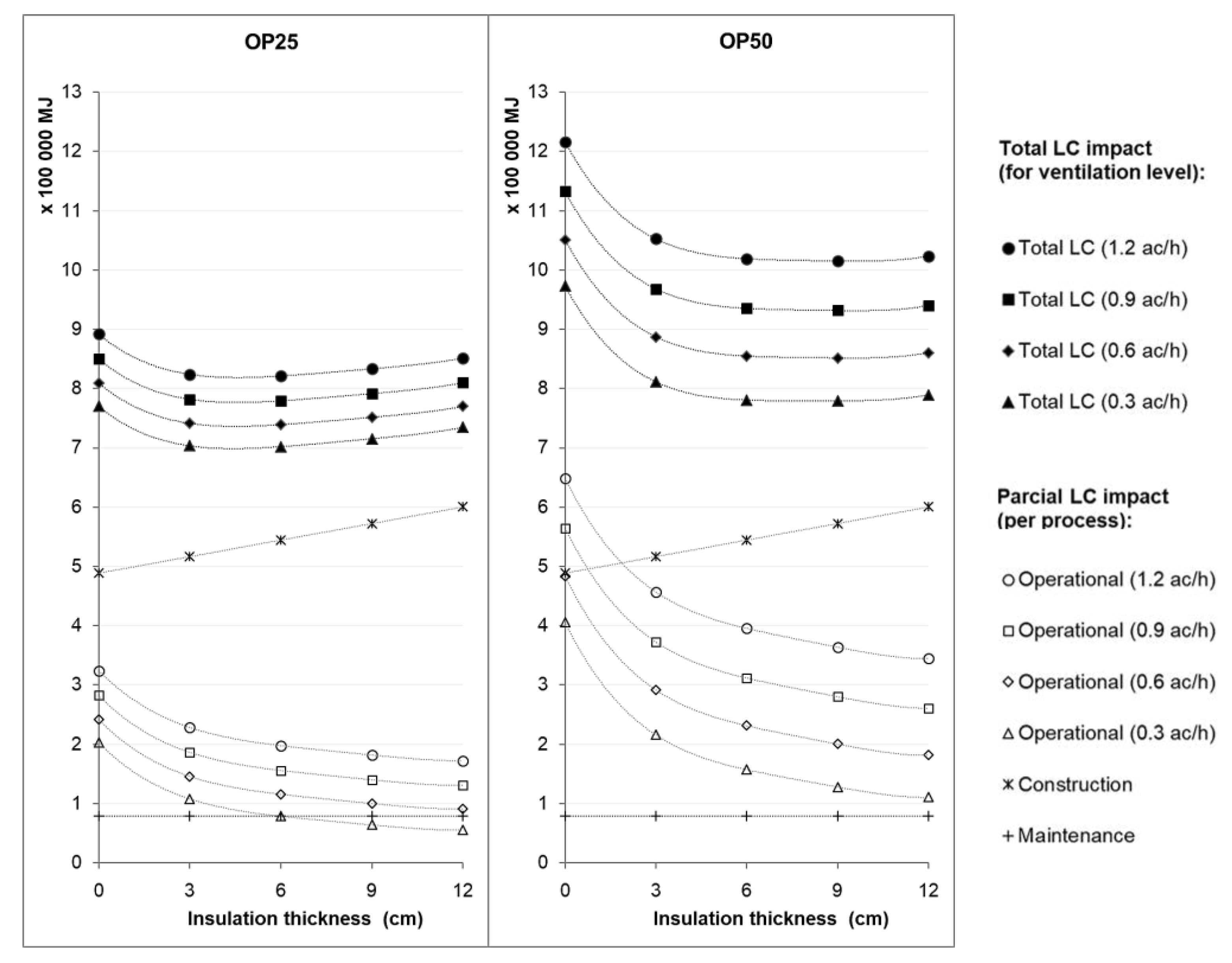
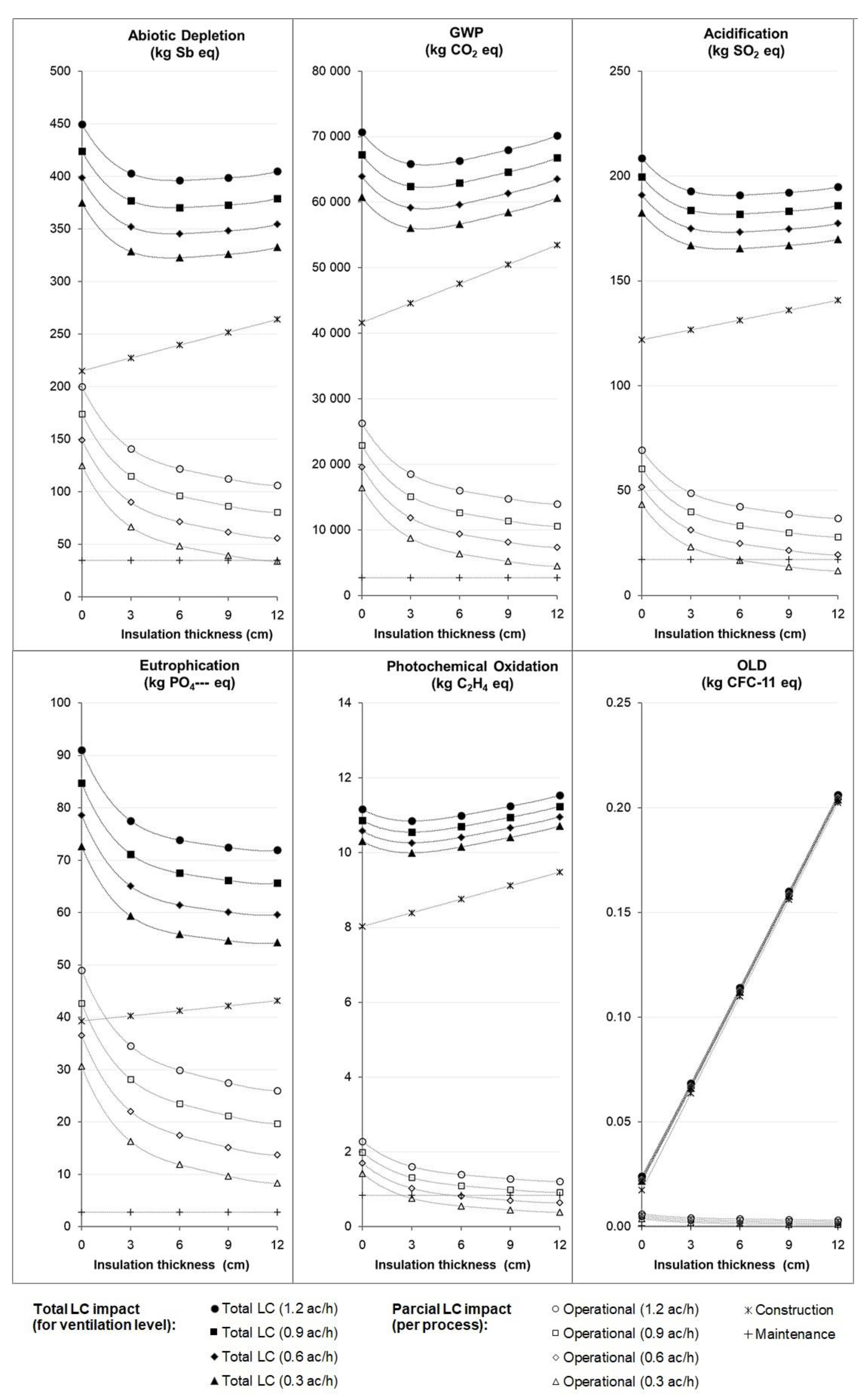
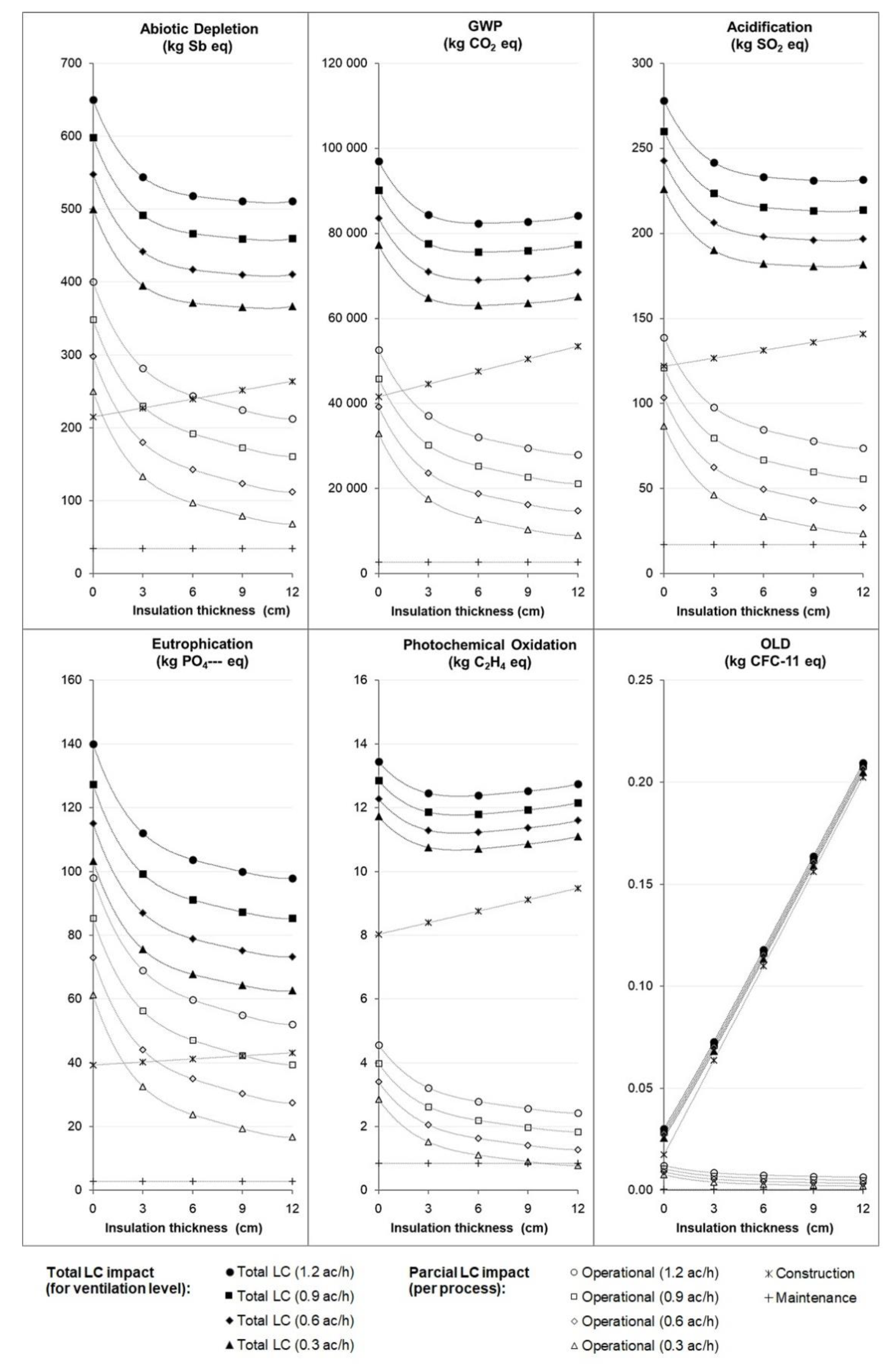

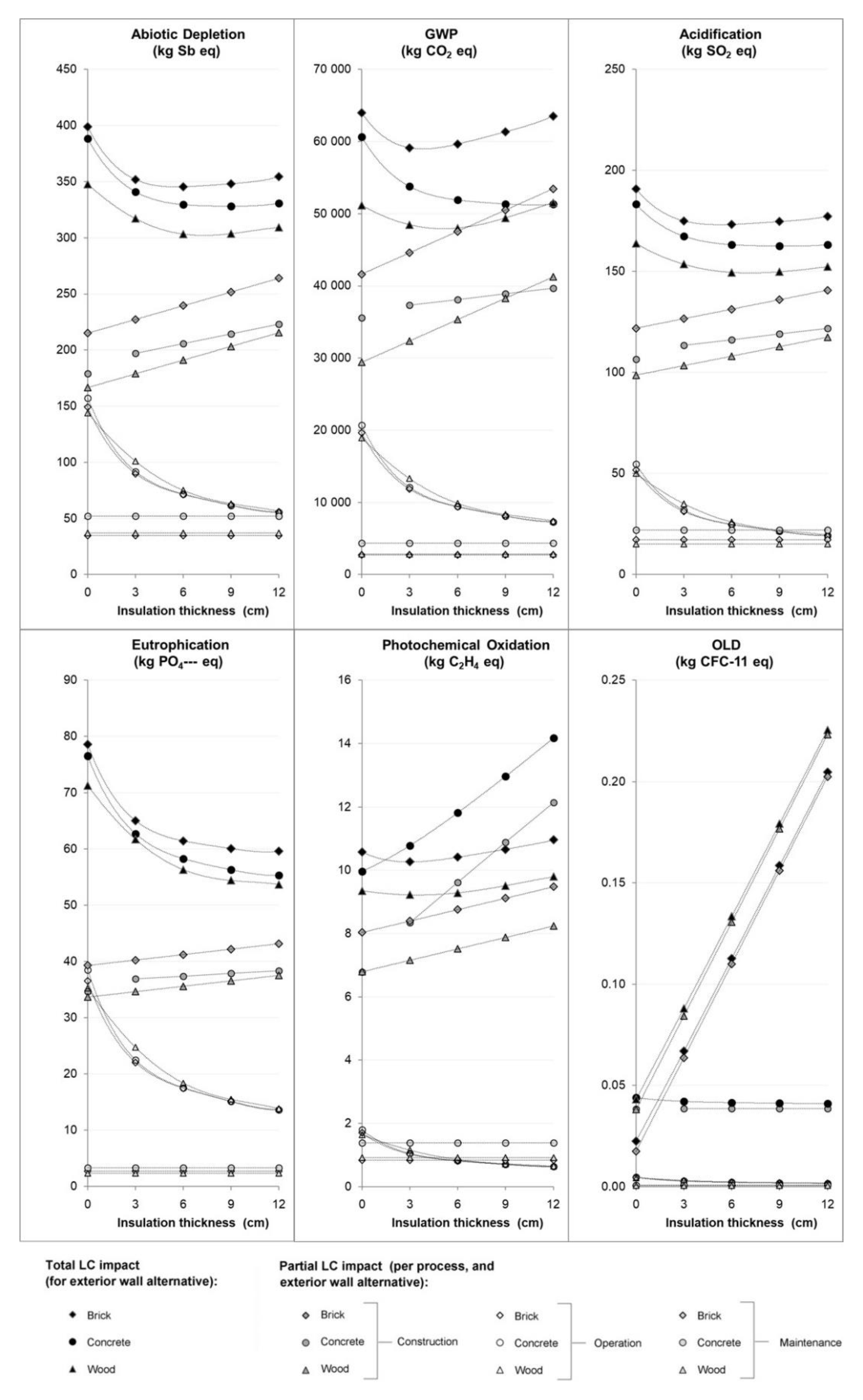

| Simplifications and Processes Out of the Scope | Reason |
|---|---|
| Energy used on construction site | It is considered of minor importance in other studies [1,45]. |
| Furniture, plumbing, sanitary equipment, heat distribution pipes, change in land use | These are not affected by the alternative building envelope options and do not affect the comparative nature of the findings. Hence, embodied impacts are underestimated in the life-cycle model. |
| Appliances and domestic hot water use, lighting | These needs are not dependent on envelope options. Improvements are independent of the building and mainly related to available technology (appliances efficiency) and user behavior. |
| Insulation materials’ thermal properties were assumed to remain the same throughout the lifespan | Though the EU standards recommend considering the aging process of construction products to estimate the decay of thermal properties, overtime was out of the scope of our study. |
| End-of-life phase | Expected to have a small life-cycle magnitude, representing less than 4% in Mediterranean dwellings (Nemry et al., 2010). Additionally, to predict waste treatment scenarios for such distant future (50 years) encompasses high uncertainty and waste treatment processes can change. |
| Building Component | Area (m2) | Units | Description |
|---|---|---|---|
| Roof | 74.4 | Gravel (0.05 m); polypropylene felt; extruded polystyrene (XPS) insulation (0.06 m); bitumen layer (0.005 m); anhydrite screed (0.05 m); reinforced concrete slab (0.15 m); lime mortar (0.02 m); U = 0.39 W/m2K. | |
| Slab | 76.4 | Wooden flooring (0.04 m square joists, air-layer, 0.02 m planks); anhydrite screed (0.03 m); reinforced concrete slab (0.15 m); lime mortar (0.02 m). | |
| Ground floor | 80 | Wooden flooring (0.04 m square joists, air-layer XPS) 0.02 m planks); lightweight anhydrite screed (0.05 m); reinforced concrete (0.12 m); gravel (0.20 m) on ground; U = 0.56 W/m2K. | |
| Structure | Beams, columns, foundations: reinforced concrete | ||
| Exterior walls | 220 | Base plaster painted; hollow-brick masonry (0.11 m); air-cavity with XPS (0.06 m); hollow-brick masonry (0.15 m); base plaster; painting; U = 0.33 W/m2K. | |
| Interior walls | 110 | Hollow-brick masonry (0.11 m); base plaster (0.02 + 0.02 m); painting. | |
| Windows | 1 | 11 | Aluminum-frame with thermal break; double-glazing U = 1.1 W/(m2 K); exterior plastic shutters |
| Doors (interior) | 1.6 | 8 | Wooden doors, varnished. |
| Exterior door | 2 | 1 | Wooden doors, varnished (U = 1.8 W/(m2K). |
| Passive Construction | Alternatives Studied | Base Case | ||
|---|---|---|---|---|
| Envelope extruded polystyrene (XPS) insulation level (cm) 1,2 | 0; 3; 6; 9; 12 | 6 | ||
| Total ventilation level, including infiltration (ac/h) 1 | 0.3; 0.6; 0.9; 1.2 | 0.6 | ||
| Exterior wall construction type | Double hollow-brick masonry (XPS insulation) | Concrete block masonry2 (EPS insulation) | Wood walls (XPS insulation) | Double hollow-brick masonry (XPS insulation) |
 |  |  |  | |
| Insulation material 1(equivalent U-value) | XPS; XPS CO2; EPS; Cork; Polyurethane rigid foam (PUR); Rock wool | XPS | ||
| Building Simulation Settings | Description |
|---|---|
| 3D build-up model | 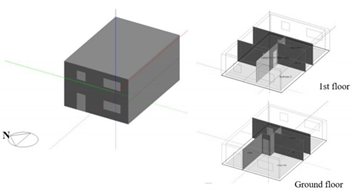 |
| Living area (m2) | 133.2 |
| Conditioned volume | 360 |
| Heating set-point air temperature (with no set-back) | 20 °C |
| Cooling set-point air temperature (with no set-back) | 25 °C |
| Heating Ventilation and Air Conditioning (HVAC)schedule; gains schedule | 0:00–24:00 (24 h/7 a year) |
| Location | Coimbra, Portugal |
| Latitude/longitude (°) | 40.2°/−8.4° |
| Elevation above sea (m) | 140 |
| Hourly weather data | PRT_Coimbra_IWEC |
| Internal gains (lumped into a single value) | 4 W per m2 of living area; as recommended by [48] |
| Air-tightness (infiltration) | Dependent on total ventilation scenario |
| Gains schedule | 0:00–24:00 (24 h/7 a year) |
| Annual Period | Days | Shutters Open | Shutters Closed (Shading) |
|---|---|---|---|
| 30 September to 30 June | weekdays | 7 h–19 h | 19 h–7 h |
| weekends | 9 h–19 h | 19 h–9 h | |
| 30 June to 30 September | weekdays | 7 h–8.5 h | 8.5 h–7 h |
| weekends | 9 h–12 h | 12 h–9 h |
| Insulation (Thermal Conductivity 1 W/m2K) | NRPE | AD | GWP | AP | EP | PO | OLD | |
|---|---|---|---|---|---|---|---|---|
| XPS CO2 | 0.035 | 1.4% | 1.4% | −7.4% | −0.5% | 0.2% | 3.2% | −96.9% |
| EPS | 0.038 | 3.5% | 3.6% | −6.4% | 0.9% | −0.2% | 45.4% | −96.9% |
| Cork | 0.038 | −6.8% | −6.3% | −10.4% | −1.1% | −0.5% | −3.3% | −96.9% |
| PUR | 0.04 | 1.3% | 0.7% | −6.4% | 3.2% | 14.0% | 4.4% | −96.7% |
| Rock Wool | 0.025 | −1.7% | −2.1% | −7.9% | 0.1% | 2.0% | −3.1% | −97.0% |
| No insulation 2 | 0.035 | −10.4% | −10.3% | −12.7% | −7.3% | −5.6% | −8.0% | −97.0% |
| Life-Cycle GWP (kg CO2eq/m2.year) | |||||
|---|---|---|---|---|---|
| Location | OP (C/P) | Operation HVAC | Construction | Maintenance | Total |
| Spain, Barcelona [14] | C | 1.7 heating 10.7 cooling | 4.5 | 2.9 | 49.4 |
| Spain, Zaragoza [26] | C | 10.2 HVAC | 10,3 | - | 25 1 |
| Spain, Lleida 2 [27] | C | 53.2 heating 21.1 cooling | 60.5 | - | 134.8 |
| Italy, Piedmont [21] | C | 0.78 HVAC | 10.8 | - | 17.4 1 |
| Portugal, Coimbra: base case house 1 | P | 2.5 heating 0.3 cooling | 7.5 | 0.4 | 10.4 |
© 2020 by the authors. Licensee MDPI, Basel, Switzerland. This article is an open access article distributed under the terms and conditions of the Creative Commons Attribution (CC BY) license (http://creativecommons.org/licenses/by/4.0/).
Share and Cite
Monteiro, H.; Freire, F.; Fernández, J.E. Life-Cycle Assessment of Alternative Envelope Construction for a New House in South-Western Europe: Embodied and Operational Magnitude. Energies 2020, 13, 4145. https://doi.org/10.3390/en13164145
Monteiro H, Freire F, Fernández JE. Life-Cycle Assessment of Alternative Envelope Construction for a New House in South-Western Europe: Embodied and Operational Magnitude. Energies. 2020; 13(16):4145. https://doi.org/10.3390/en13164145
Chicago/Turabian StyleMonteiro, Helena, Fausto Freire, and John E. Fernández. 2020. "Life-Cycle Assessment of Alternative Envelope Construction for a New House in South-Western Europe: Embodied and Operational Magnitude" Energies 13, no. 16: 4145. https://doi.org/10.3390/en13164145
APA StyleMonteiro, H., Freire, F., & Fernández, J. E. (2020). Life-Cycle Assessment of Alternative Envelope Construction for a New House in South-Western Europe: Embodied and Operational Magnitude. Energies, 13(16), 4145. https://doi.org/10.3390/en13164145






